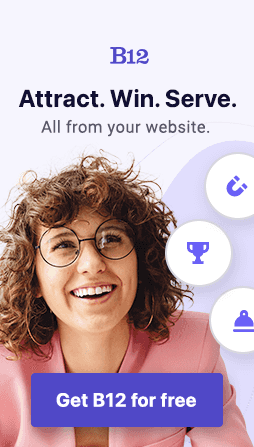Build an AI website in 60 seconds
AI generates your personalized website instantly with built-in scheduling, payments, email marketing, and more.
Start for free
How to create a landing page that captures leads

A landing page is essential in any digital marketing strategy. It is a specifically designed web page or blog post that aims to convert website visitors into customers. However, creating a high-converting landing page requires more than just a few pictures and a call to action. For instance, it involves having a simple layout that compels visitors to stay on your page. An effective landing page with a layout that minimizes distractions can boost conversions by 10%!
Keep reading on to discover how to create a landing page that increases your conversion rate.
Understanding the purpose of landing pages
A well-crafted landing page is any page on your website that is designed to receive traffic from a specific source or campaign. Here are some of the purposes of a landing page:
Converts visitors into leads
The primary goal of most landing pages is to convert visitors into leads by collecting their contact information. To achieve this goal, a great landing page usually offers visitors something of value. For instance, a free e-book or a discount code for a product or service.
A great landing page also serves as an email marketing tool. With a custom landing page, you can include a signup form for your email newsletter or collect email addresses.
Highlights your offers
High-converting landing pages are designed to isolate visitors from other distractions on the website. Unlike other pages, landing pages have no menus or links to other pages. This is because any other information on the landing page could easily take visitors away from the primary offering, thus reducing the chance of conversion. The purpose of a landing page is to present a specific offer and drive a specific action without leaving visitors with other options to explore.
Improves your SEO
Another purpose for landing pages is to improve your website's SEO. The high-converting landing pages function as pillars for your website's optimization. By creating relevant and persuasive content, stunning landing pages can attract other sites' backlinks and generate referral traffic. This only happens if the pages are optimized for search engines, which usually means having clear and concise content, a fast load time, and appropriate on-page SEO factors. Ultimately, the purpose of a landing page is to get visitors to take a specific action. Examples include filling out a form, making a purchase, or calling your company.
How to create a landing page
Want to create a new landing page for your business? Or maybe you're ready to create your first landing page. Here are some landing page best practices that you can follow.
Identifying your target audience for your landing page
The purpose of a good landing page is to convert visitors into leads or customers, so understanding who you are targeting is paramount. Why? By knowing who you’re targeting, you can tailor your landing page design and message to appeal to that specific audience.
To identify your target audience, think about your product or service's unique selling proposition (USP). How does your product or service stand out? Who benefits most from it? Don’t forget to consider demographic factors. These include age, gender, income, education level, and other factors.
You can conduct market research to gain insights into your target audience. Online surveys, phone or email interviews, and social media listening are some effective methods. Once you understand your target audience, you can create a landing page that visitors connect with.
Remember that your landing page's messaging and design should align with your brand and the rest of your online marketing campaigns. If you have identified multiple target audiences, consider creating different landing pages for each one instead of trying to appeal to everyone on a single page. By doing so, you will increase the chances of converting visitors into leads or customers.
Creating a compelling headline
The headline of your landing page is the first thing that your target audience will see, and it determines the effectiveness of your page. So make your headline clear, concise, and attention-grabbing. A well-crafted headline should communicate the benefit of your offer and persuade your target audience to take action. Therefore, it is essential to spend time brainstorming and testing different headlines before launching your landing page.
One way to create a compelling headline is by understanding the pain points and needs of your target audience. If people feel you relate to their problems and can offer solutions, then they’re more likely to take action. Therefore, create a headline that speaks directly to your target audience's problems and offers a solution. Another approach is to make your headline unique and memorable. The internet is saturated with information, and a headline that stands out will capture your target audience's attention and make them curious to learn more.
It is essential to include a benefit-oriented subheadline that complements your headline. The headline typically gets the audience's attention. But the subheadline informs them of what they will gain by clicking the call-to-action button. The subheadline should be a few words longer than the headline and should paint a vivid picture of the benefit of your offer. A subheadline that complements the headline can help reduce confusion and increase conversion rates.
Remember to keep your headline short and sweet. The attention span of internet users is fleeting, and a long headline will discourage them from reading your landing page. So your headline should ideally be no more than 10-15 words. A short headline is also more memorable, and it allows you to convey your message more quickly, which increases the chances of conversion.
Crafting effective and clear calls to action
An effective and clear call to action is one of the most critical aspects of creating a successful landing page. The CTA is typically the button that the user clicks to take the desired action you want them to take. Whether the goal of the landing page is to generate leads, sell products or services, or get visitors to register for an event, the CTA must be clear, concise, and compelling.
One of the best practices for crafting an effective CTA is to use action-oriented language. This means using verbs that encourage people to take action, such as "Download Now," "Sign Up Today," or "Get Your Free Trial." In addition to using action-oriented language, consider using urgent language as well. For example, "Limited time offer – Act now" can create a sense of urgency that motivates users to take action quickly.
Another key element of a successful CTA is its design. The CTA button should be easy to find and stand out from the rest of the content on the page. The color you choose should contrast with the background and the font should be easy to read. Additionally, make sure the size of the CTA button is large enough to be easily clicked on desktop and mobile devices.
Before you hit publish, don’t forget to place the CTA in a strategic location on the landing page. Typically, it is best practice to place the CTA above the fold, meaning users can see the button without having to scroll down the page. However, avoid putting too many CTAs on the page as much as possible. This can be overwhelming for the user and can turn them away from your page.
Designing a clean and simple layout
A clean and simple layout is essential to keep visitors’ focus on the content of the landing page. A cluttered and overwhelming page design can lead to confusion and distraction. So make sure the page’s layout is visually appealing and easy to navigate. An organized and well-structured page with clear sections and white spaces can improve the user experience and increase the chances of conversion.
The color scheme of the landing page should be consistent with the brand identity to create a cohesive look and feel. The use of contrasting colors can make the important elements stand out, such as the headline, call-to-action buttons, and form fields. However, the use of too many colors or overly bright colors can be distracting and turn off the users. So try to strike a balance between aesthetics and usability.
Custom illustrations and videos can enhance the visual appeal of the landing page and convey the message more effectively. However, the media files should be optimized for fast loading times and not compromise page speed. Moreover, stock photos and videos should be relevant and add value to the content of the page. Using too many or irrelevant media files can overcrowd the page and delay the conversion process. You can consider placing your business logo or a relevant hero image using a drag-and-drop builder.
Mobile responsiveness is another critical aspect of landing page design, as more and more users are accessing the internet from their smartphones and tablets. A mobile-friendly landing page should be easy to view, navigate, and interact with on any screen size. It is important to test the landing page on different devices and browsers to ensure compatibility and functionality. A seamless and responsive landing page can improve the user experience and lead to higher conversion rates.
Optimizing your landing page for SEO and conversion
It’s crucial to create the best landing page, one that can drive more traffic and convert visitors into customers. Want to increase your chances of conversion? Then prioritize optimizing your landing page for both SEO and conversion. Search engine optimization ensures that your landing page is discoverable on search engines like Google. Meanwhile, conversion optimization focuses on creating an effective user experience that leads visitors to take the desired action.
When optimizing your landing page for SEO, relevant keywords play a crucial role. People enter keywords into search engines when they’re looking for information, products, or services. Conducting thorough keyword research is essential when building a strong SEO strategy. Integrating relevant and high-traffic keywords into your landing page content and metadata can increase the page’s visibility on search engine results pages (SERPs). When your landing pages rank well, this ultimately helps drive traffic to your own website.
Conversion optimization is all about keeping your visitors engaged and moving them through the sales funnel smoothly. Paying attention to the usability and design of your landing page is a critical aspect of conversion optimization. The page should be easy to navigate, aesthetically pleasing, and mobile-friendly. Break up the page into smaller sections, and use clear and concise language for your landing page copy. Moreover, highlight the key benefits and features of your product or service.
So how do you measure your landing page’s success? The answer is to track conversion rates. Analyze your landing page metrics, such as click-through rates, bounce rates, and time on site. Afterward, make adjustments based on the data provided by Google Analytics or other tools. By tracking and adjusting your landing page for SEO and conversion, you can continue to optimize your page’s performance. And the result? You’d likely get more conversions and revenue!
Capture leads effortlessly with B12
Make a great first impression on leads and clients using B12. Access our prebuilt design themes and landing page templates, or work with a B12 designer on a more customized landing page design. Either way, your pages are built to attract and capture more leads with intake forms, pop-ups, announcement banners, live chat, and more. Sign up for free today and see your new website draft in 60 seconds.
Attract, win, and serve more clients
Receive helpful resources directly to your inbox to help you succeed online.
Draft your site in 60 seconds
Get an AI website made specifically for you that's free to launch.
Start for free ✨No credit card required
Related posts
Spend less time on your website and more time growing your business
Let B12 set up your professional online presence with everything you need to attract, win, and serve clients.





